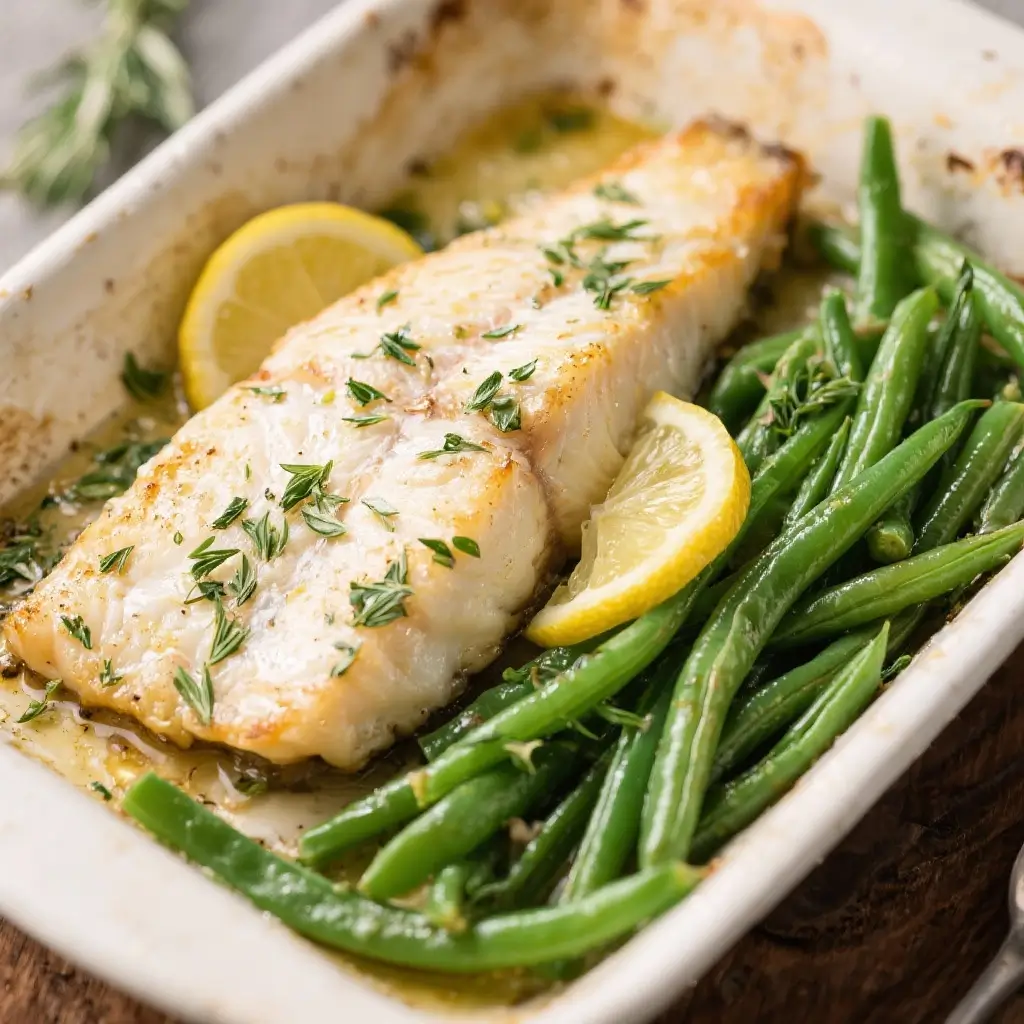Lemon Herb Baked Halibut with Sautéed Green Beans
Introduction
Lemon Herb Baked Halibut with Sautéed Green Beans is a dish that perfectly marries elegance and simplicity. Ideal for both weeknight dinners and special occasions, this recipe highlights the delicate flavor of fresh halibut enhanced by bright citrus notes, aromatic herbs, and tender-crisp green beans sautéed to perfection. With its vibrant colors, clean ingredients, and balanced nutrition, this meal not only satisfies the palate but also supports a wholesome lifestyle. Whether you’re a seasoned home cook or just beginning your culinary journey, this dish offers an accessible yet refined way to enjoy seafood in a healthy, flavorful format.
The History
Seafood has long been a cornerstone of coastal cuisines around the world, and baked fish dishes have roots stretching back centuries across Mediterranean, Scandinavian, and Pacific Northwest traditions. The practice of baking fish with lemon and herbs dates back to ancient Greece and Rome, where cooks used olive oil, wine, garlic, and wild herbs to enhance the natural sweetness of freshly caught fish. In France, papillote (cooking in parchment) evolved as a gentle method to preserve moisture and aroma—similar principles apply in modern baking techniques.
Halibut, named after the Old English word “haly,” meaning holy, was traditionally consumed on religious feast days due to its firm texture and mild taste, making it suitable for fasting periods when meat was forbidden. Native American tribes of the Pacific Northwest revered halibut as both food and spiritual symbol, often preparing it over open fires or in steaming pits. Today’s version—Lemon Herb Baked Halibut—draws from these rich cultural lineages while embracing contemporary health-conscious cooking styles. Paired with seasonal vegetables like green beans, this dish reflects a global evolution toward lighter, plant-forward meals without sacrificing flavor or satisfaction.
Ingredients Breakdown
Halibut: This lean, white-fleshed fish is known for its buttery texture and mild, slightly sweet flavor. It’s an excellent canvas for bold seasonings like lemon and herbs. Opt for sustainably sourced, skinless fillets about 6–8 ounces each and 1 to 1.5 inches thick for even cooking.
Fresh Lemon: Provides acidity that brightens the entire dish. Both zest and juice are used—one enhances fragrance, the other adds tang. Freshly squeezed lemon juice ensures optimal flavor compared to bottled versions.
Olive Oil: Extra virgin olive oil acts as a carrier for flavors, keeps the fish moist during baking, and helps crisp the surface slightly. Its heart-healthy monounsaturated fats make it ideal for this dish.
Fresh Herbs: A blend of parsley, dill, thyme, and optionally chives or tarragon delivers aromatic complexity. Parsley brings freshness, dill contributes a subtle anise note, and thyme adds earthiness. Dried herbs can substitute in a pinch but lack vibrancy.
Garlic: Minced fresh garlic infuses depth and warmth into the marinade, enhancing umami without overpowering the delicate fish.
Salt & Black Pepper: Essential seasoners that balance and elevate all other components. Sea salt or kosher salt is preferred for better texture and mineral content.
Green Beans: Also known as string beans or snap beans, they add color, crunch, and nutrients. Choose firm, slender pods with vibrant green hue—avoid limp or yellowing ones.
Shallot or Onion: Finely chopped shallots offer mild sweetness and complexity when sautéed, forming a flavorful base for the green beans.
Butter or Olive Oil (for sautéing): Butter lends richness and nuttiness, especially if browned slightly; olive oil keeps it dairy-free and aligns with Mediterranean style.
Lemon Zest (optional extra): Adds a final pop of citrus aroma when sprinkled on top before serving.
Cherry Tomatoes or Almonds (optional garnish): For added visual appeal and complementary textures—tomatoes bring juiciness, toasted almonds provide crunch.
Step-by-Step Recipe
- Preheat the Oven: Begin by preheating your oven to 375°F (190°C). Line a baking sheet with parchment paper or lightly grease it with olive oil to prevent sticking.
- Prepare the Halibut Fillets: Pat the halibut fillets dry using paper towels—this step is crucial for proper seasoning adherence and browning. Place them on the prepared baking sheet, leaving space between each piece for even heat circulation.
- Make the Lemon-Herb Marinade: In a small bowl, whisk together 3 tablespoons of extra virgin olive oil, juice of half a lemon (about 2 tablespoons), 1 teaspoon of lemon zest, 2 minced garlic cloves, 1 tablespoon chopped fresh parsley, 1 tablespoon chopped fresh dill, 1 teaspoon chopped fresh thyme leaves, ½ teaspoon sea salt, and freshly ground black pepper to taste. Mix well until fully combined.
- Season the Fish: Spoon the lemon-herb mixture evenly over the top of each halibut fillet, gently rubbing it in to coat all surfaces. Allow the fish to marinate at room temperature for 10–15 minutes to absorb the flavors.
- Bake the Halibut: Transfer the baking sheet to the preheated oven and bake for 12–15 minutes, depending on thickness. The halibut is done when it flakes easily with a fork and reaches an internal temperature of 130–135°F (54–57°C), continuing to rise slightly upon resting. Avoid overbaking to maintain moisture.
- Rest the Fish: Remove the halibut from the oven and let it rest for 3–5 minutes. This allows juices to redistribute, ensuring every bite remains succulent.
- Wash and Trim Green Beans: While the fish rests, rinse 1 pound of fresh green beans under cold water. Trim off the stem ends and any tough tips. You may cut them into 2-inch pieces or leave whole for elegance.
- Blanch the Green Beans (Optional): For vibrant color and tender texture, blanch the beans in boiling salted water for 2 minutes, then immediately plunge into ice water to stop cooking. Drain thoroughly. This step is optional but recommended for best results.
- Sauté the Green Beans: Heat 1 tablespoon of olive oil or butter in a large skillet over medium-high heat. Add 1 finely chopped shallot and sauté for 1–2 minutes until translucent. Add the green beans and cook for 4–6 minutes, stirring occasionally, until crisp-tender. If desired, splash with 2 tablespoons of water and cover briefly to steam if needed.
- Season the Vegetables: Stir in a pinch of salt, freshly ground black pepper, ½ teaspoon lemon zest, and 1 teaspoon of fresh lemon juice. Toss well to combine. Taste and adjust seasoning as necessary.
- Plate the Dish: Place one halibut fillet onto each warmed plate. Arrange a generous portion of sautéed green beans alongside. Drizzle any accumulated juices from the fish over the top for extra flavor.
- Garnish and Serve: Sprinkle with additional chopped fresh herbs and a twist of lemon zest. Optionally, add halved cherry tomatoes, capers, or toasted sliced almonds for contrast. Serve immediately while warm.
Tips
- Choose High-Quality Fish: Look for halibut that smells clean and ocean-fresh, never fishy. Flesh should be translucent, firm, and free of blemishes or drying edges.
- Don’t Skip the Resting Step: Letting the fish rest after baking preserves moisture and improves texture dramatically.
- Use Parchment Paper: Baking on parchment prevents sticking and makes cleanup effortless. It also reduces the risk of over-browning on the bottom.
- Adjust Cooking Time Based on Thickness: Thicker fillets may need up to 18 minutes, while thinner ones could be ready in 10. Always check doneness with a fork or thermometer.
- Enhance Flavor with Wine: Add 2 tablespoons of dry white wine (like Sauvignon Blanc or Pinot Grigio) to the herb marinade for a more complex profile.
- Toast Your Herbs Lightly: Briefly sautéing herbs in olive oil before adding them to the marinade intensifies their aroma.
- Double the Sauce for Serving: Prepare extra lemon-herb oil to drizzle over the plated dish or serve on the side for dipping.
- Batch-Cook Smart: This recipe scales beautifully—double or triple for meal prep. Store components separately in airtight containers for up to 3 days.
- Prevent Overcrowding: Ensure space between fillets on the baking tray so steam escapes and the tops don’t become soggy.
- Add Umami Boosters: A few drops of fish sauce or anchovy paste in the marinade deepen savory notes without tasting fishy.
Variations and Customizations
- Herb Swaps: Replace dill with basil in summer for a sweeter, more floral touch, or use rosemary sparingly for a woodsy accent. Cilantro works well for a Latin-inspired twist.
- Spice It Up: Add red pepper flakes (¼–½ tsp) to the marinade or sprinkle smoked paprika on the fish before baking for a hint of heat and smokiness.
- Citrus Varieties: Substitute lime or orange for part of the lemon for tropical flair. Blood orange pairs beautifully with thyme and halibut.
- Crust Options: Top fillets with a breadcrumb-herb crust made from panko, Parmesan, lemon zest, and melted butter for extra texture.
- Dairy-Free Creaminess: Stir a teaspoon of tahini or coconut milk into the herb marinade for a richer mouthfeel without dairy.
- Vegetable Substitutions: Swap green beans with asparagus, broccolini, zucchini ribbons, or sugar snap peas based on seasonality.
- Gluten-Free Friendly: This recipe is naturally gluten-free. Just ensure all added ingredients (e.g., broth, sauces) meet dietary needs.
- Pescatarian Power Bowl: Serve over quinoa, farro, or brown rice with roasted cherry tomatoes, olives, and feta cheese for a complete grain bowl.
- Mediterranean Style: Add Kalamata olives, sun-dried tomatoes, and capers to the green beans for a Greek-inspired variation.
- Asian Fusion Twist: Use ginger instead of garlic, soy sauce or tamari in place of salt, and garnish with scallions and sesame seeds. Replace dill with cilantro.
- Keto/Low-Carb Option: Keep it simple with just fish and veggies—no grains. Add avocado slices on the side for healthy fats.
- One-Pan Version: Arrange green beans around the halibut on the same baking sheet and toss with olive oil and seasoning. Roast together at 375°F for 15 minutes for easy cleanup.
Health Considerations and Nutritional Value
Lemon Herb Baked Halibut with Sautéed Green Beans is a nutrient-dense, heart-healthy meal that supports overall wellness. Here’s a breakdown of its key health benefits:
- High-Quality Protein: Halibut provides approximately 42 grams of protein per 6-ounce fillet, essential for muscle repair, immune function, and satiety.
- Omega-3 Fatty Acids: Though lower than fatty fish like salmon, halibut still contains beneficial omega-3s (EPA and DHA), which support brain health, reduce inflammation, and promote cardiovascular wellness.
- Low in Saturated Fat: This preparation uses minimal added fat, primarily heart-healthy unsaturated fats from olive oil.
- Rich in Vitamins and Minerals: Halibut is a good source of selenium (a powerful antioxidant), vitamin B6, B12, phosphorus, and magnesium. Selenium plays a role in thyroid function and DNA synthesis.
- Fiber-Rich Vegetables: Green beans contribute dietary fiber (about 4g per cup), aiding digestion, stabilizing blood sugar, and supporting gut microbiota.
- Vitamin C and Antioxidants: Lemon juice and zest deliver vitamin C, which boosts immunity and enhances iron absorption. Green beans contain lutein and zeaxanthin, antioxidants linked to eye health.
- Low Glycemic Index: Naturally free of refined carbohydrates, this dish is suitable for low-carb, diabetic-friendly, and keto diets when monitored appropriately.
- Hydration Support: High water content in both fish and vegetables helps maintain hydration and cellular function.
- Anti-Inflammatory Properties: The combination of olive oil (oleocanthal), garlic (allicin), and herbs (polyphenols) creates an anti-inflammatory effect beneficial for chronic disease prevention.
Nutritional Estimate (per serving, serves 4):
| Nutrient | Amount |
|---|---|
| Calories | ~320 kcal |
| Protein | 42 g |
| Fat | 12 g (mostly unsaturated) |
| Saturated Fat | 2 g |
| Carbohydrates | 8 g |
| Dietary Fiber | 4 g |
| Sugar | 3 g (naturally occurring) |
| Sodium | ~450 mg (adjustable) |
| Vitamin C | 30% DV |
| Vitamin K | 25% DV |
| Selenium | 100% DV |
Note: Values are approximate and may vary based on ingredient brands and portion sizes.
Ingredients
For the Lemon Herb Baked Halibut:
- 4 skinless halibut fillets (6–8 oz each, ~1 inch thick)
- 3 tablespoons extra virgin olive oil
- Juice of ½ large lemon (~2 tbsp)
- 1 teaspoon lemon zest
- 2 cloves garlic, minced
- 1 tablespoon fresh parsley, finely chopped
- 1 tablespoon fresh dill, finely chopped
- 1 teaspoon fresh thyme leaves (or ½ tsp dried)
- ½ teaspoon sea salt
- Freshly ground black pepper, to taste
For the Sautéed Green Beans:
- 1 pound fresh green beans, trimmed
- 1 tablespoon olive oil or butter
- 1 shallot, finely chopped (or ¼ cup onion)
- ½ teaspoon sea salt
- Freshly ground black pepper, to taste
- ½ teaspoon lemon zest
- 1 teaspoon fresh lemon juice
- Optional: 2 tablespoons toasted slivered almonds or pine nuts
- Optional garnish: chopped fresh herbs, cherry tomatoes, or microgreens
Directions
- Preheat Oven: Set oven to 375°F (190°C). Line a baking sheet with parchment paper.
- Prepare Halibut: Pat fillets dry with paper towels and place on the baking sheet.
- Make Marinade: In a bowl, mix olive oil, lemon juice, lemon zest, garlic, parsley, dill, thyme, salt, and pepper.
- Marinate Fish: Spoon mixture over halibut, coating evenly. Let sit 10–15 minutes at room temperature.
- Bake Halibut: Bake 12–15 minutes until fish flakes easily and reaches 130–135°F internally.
- Rest Fish: Remove from oven and rest 3–5 minutes.
- Trim Green Beans: Wash and trim ends. Optional: blanch in boiling water for 2 minutes, then shock in ice water.
- Sauté Aromatics: Heat oil or butter in a large skillet over medium-high. Add shallot; cook 1–2 minutes until soft.
- Cook Green Beans: Add green beans to skillet. Sauté 4–6 minutes until crisp-tender, stirring frequently. Splash with water if needed to steam.
- Season Beans: Add salt, pepper, lemon zest, and lemon juice. Toss to combine. Stir in optional nuts.
- Plate and Serve: Place halibut on plates, side with green beans. Drizzle with pan juices, garnish with herbs and lemon zest. Serve immediately.
FAQ
- Can I use frozen halibut?
- Yes, but thaw it slowly in the refrigerator overnight for best texture. Never cook halibut from frozen, as it will release too much water and become mushy.
- What can I substitute for halibut?
- Cod, haddock, sea bass, or tilapia work well. Adjust cooking time accordingly since some fillets are thinner.
- Can I make this ahead of time?
- You can prep the marinade and trim green beans a day in advance. However, bake the fish and sauté beans just before serving for peak freshness.
- Is halibut sustainable?
- It depends on sourcing. Look for MSC-certified or U.S.-farmed halibut to ensure environmental responsibility.
- Why did my fish turn out dry?
- Overcooking is the most common cause. Use a thermometer and remove fish at 130–135°F—it will continue to cook off the heat.
- Can I grill instead of bake?
- Absolutely! Grill over medium heat (375°F) for 4–6 minutes per side, depending on thickness. Use a fish basket or foil to prevent sticking.
- Are green beans healthy?
- Yes—they’re low in calories, high in fiber, vitamins A, C, K, and folate, and contain antioxidants that support long-term health.
- How do I store leftovers?
- Store cooled fish and beans separately in airtight containers in the refrigerator for up to 2 days. Reheat gently in the oven or microwave with a splash of water.
- Can I freeze this dish?
- While possible, freezing cooked halibut often results in texture degradation. Better to freeze raw marinated fillets for up to 2 months.
- Is this recipe kid-friendly?
- Yes! The mild flavor of halibut and colorful veggies appeal to children. Serve with a side of mashed potatoes or rice for picky eaters.
Summary
Lemon Herb Baked Halibut with Sautéed Green Beans is a nutritious, elegant, and easy-to-make dish that celebrates fresh ingredients and bold flavors. Perfect for healthy weeknights or impressive dinners, it combines flaky white fish with vibrant vegetables in a citrusy herb marinade for a meal that delights both palate and body.










